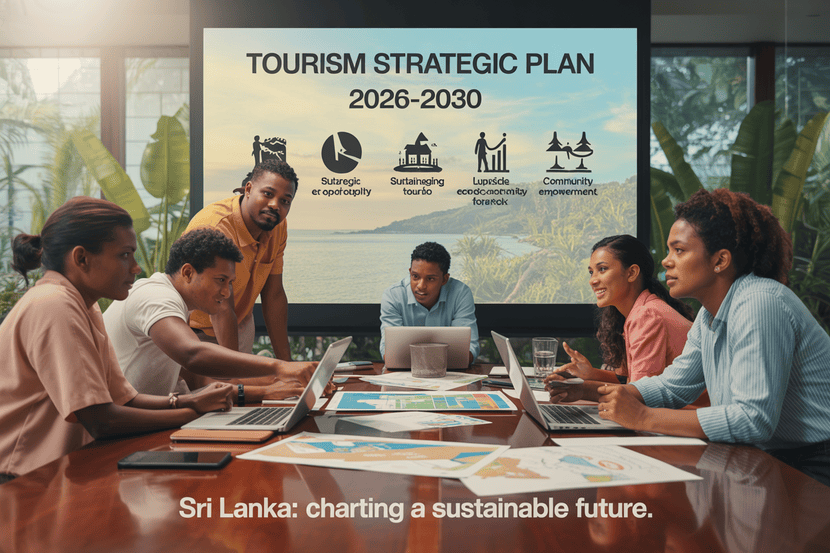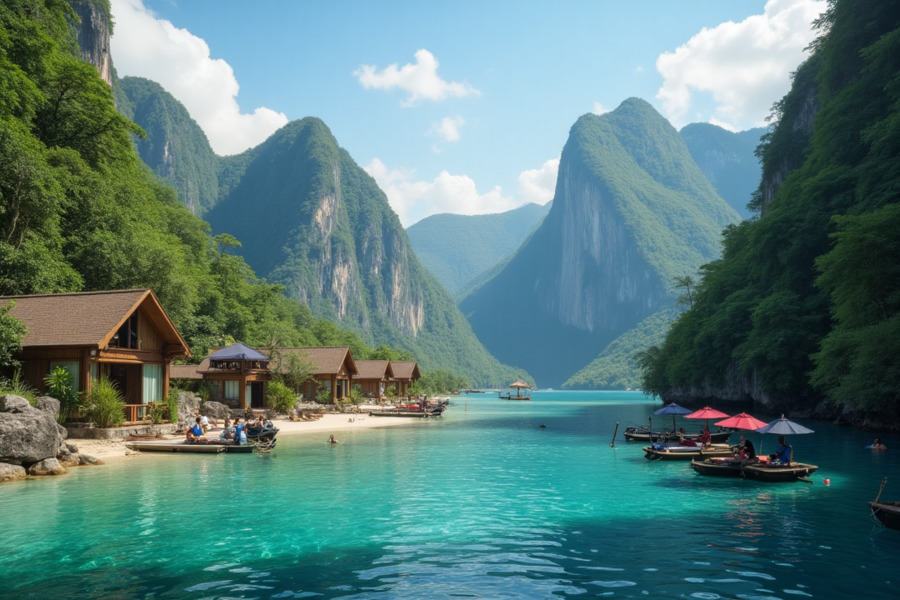≡-UAE, Saudi Arabia, Qatar, Turkey, Oman, Jordan, and Egypt Set to Transform Middle East into a Tourism Powerhouse in Next Five Years with Mega Airport, New Hotel Expansions and More – Viral of Today
<> Viral of Today <>
Home » EGYPT TRAVEL NEWS » UAE, Saudi Arabia, Qatar, Turkey, Oman, Jordan, and Egypt Set to Transform Middle East into a Tourism Powerhouse in Next Five Years with Mega Airport, New Hotel Expansions and More Thursday, July 10, 2025UAE, Saudi Arabia, Qatar, Turkey, Oman, Jordan, and Egypt will make the Middle East the tourism centre of the next five years with mega airport initiatives, fresh hotel openings, and global-scale infrastructure spending, the ATM Travel Trends Report 2025 reveals. Backed by estimated regional tourism spending of US$350 billion by 2030, the report points out how seven of these countries are bringing growing airport traffic, high-end hotels, sports tourism, and cultural advancement together to make the Middle East one of the fastest-developing and most strategically connected travel areas around the globe.UAE To Soar as the Luxury Gateway to the Middle East with Record-Breaking Airport Expansion and Hotel AmbitionsBreaking Records: UAE tourism reaches all-time high in arrival and spending termsTourism statistics disclose the UAE’s position as the must-go destination. In 2024, Dubai hosted 18.72 million inbound tourists, exceeding its pre-pandemic figures. The trend persisted in 2025, where 7.15 million tourists were registered in the first four months of the year—a 7% increase from the previous year. Dubai is now one of the world’s leading city destinations and evidence of the success of its open border policy, events schedule, and world-class visitor infrastructure.Looking ahead, the UAE’s 2031 tourism vision targets 40 million tourists per annum and aims to increase tourism’s GDP contribution to AED 450 billion (US$122 billion). Visitor spending is expected to touch US$62 billion in 2025, 37% more than in 2019. Buzz is also building around the unified GCC tourist visa, to facilitate easy regional travel between the UAE, Saudi, Oman, Qatar, and other states—fueling more cross-border movement and multi-country trips.The UAE’s Sky-High Ambitions: Building the World’s Biggest AirfieldThe UAE is redefining the face of global aviation with record-breaking airport developments, led by the US$35 billion Al Maktoum International Airport (DWC) expansion in Dubai. Designed to be the biggest airport in the world by 2034, the mega-hub will be equipped with five parallel runways and over 400 aircraft gates, handling 260 million annual passengers. The initiative also involves transferring operations from the current Dubai International Airport (DXB) to DWC in order to create the largest aerotropolis supported by logistics, hospitality, and next-generation smart infrastructure.Even as it looks to the future, Dubai is continuously refreshing its existing air assets. The next five to seven years will see between US$2.7 billion and US$3 billion in refurbishments to Terminal 3 at DXB, already one of the busiest terminals in the world. Abu Dhabi’s Zayed International Airport Terminal A, inaugurated in 2024 at a cost of US$3 billion, now brings 12 million passenger per annum capacity, with the capacity to increase to 45 million. Through the implementation of facial recognition and smart aviations powered by artificial intelligence, the UAE is leading the region’s transition to smart, seamless aviations.From Desert Palaces to Island Icons: UAE’s Hotel Boom Redefines LuxuryHotel development in the UAE is catching up with its air travel spike, with 102 hotels in the planning at Q1 2025, featuring over 27,000 rooms. The Wynn Al Marjan Island in Ras Al Khaimah is one of them—a US$2.4 billion mega-resort featuring 1,542 rooms, gaming space, private villas, and high-end retail and entertainment venues. The project by itself will create the emirate as a high-end tourism destination.Dubai continues its regional hospitality dominance with newly-opened flagships at Marina, Downtown, and Jumeirah, as Abu Dhabi constructs its corridors on Saadiyat and Yas Island. Top global brands like Hilton, Accor, Mandarin Oriental, and Marriott continue to expand city-center and seacoast footprints. With each successive opening, the UAE raises the bar for service, sustainability, and full guest experiences—all ensuring the five-star capital of the Middle East its position.Sporting Glory: UAE Transforms Events Into Year-Round Tourism EnginesThe UAE has also made sporting and entertainment high-powered tourism magnets. Abu Dhabi’s Formula 1 Grand Prix, held at Yas Marina Circuit, continues to create global buzz, and Dubai features high-end events like the Dubai Duty Free Tennis Championships, UFC events, and DP World Tour golf. The events routinely sell out hotels, create global air traffic, and position the UAE as a high-end sporting destination.Esports is growing even faster. Dubai is building dedicated gaming infrastructure to appeal to high-end events and digitally native fans. The formula is familiar: use global sport to fill hotel rooms, boost average lengths of stay, and create international cache. By doing this, the UAE brands itself as more than stopover, but destination in its own right—you know, where sporting tourism is one of the cornerstones of round-the-year visitation.Bold Bets: UAE Spends Billions to Create Next-Gen Tourism EconomyAided by the UAE 2031 Tourism Strategy, the country has committed AED 100 billion (US$27 billion) to tourism over the next decade. Money is being spent to boost infrastructure, digital creation, service to visitors, and tourism promotion for the destination. The goal is straightforward: diversify beyond petroleum and create one of the world’s most competitive, experience-based visitor economies. Besides government expenditure, major players such as Emaar, Nakheel, and Meraas are launching lifestyle megaprojects such as Dubai Harbour, Bluewaters Island, and The Palm Tower. Themegaprojects blend hotels, restaurants, entertainment, and retail in one-stop destinations. By means of these mixed public-private developments, the UAE is being rebranded as a globally recognized business, leisure, and luxury destination.Dubai, United Arab EmiratesWhere futuristic luxury meets desert adventureTop Things to DoSnap a skyline photo from the Burj Khalifa, the tallest building in the worldExplore traditional Arabian life at Al Fahidi Historical District and the Dubai CreekShop and ski indoors at Mall of the Emirates or head to the Dubai Mall’s aquariumRelax at Jumeirah Beach, then book a desert safari for dune bashing and Bedouin dinnersWhere to StayAtlantis The Royal for sky-high opulence and waterpark funAddress Downtown for unbeatable views of the Burj Khalifa and fountainsBudget travelers love Rove Hotels for modern comfort and great locationsWhy It Stands OutDubai combines ultra-modern architecture, luxury shopping, and cultural heritage in one seamless experience—ideal for stopovers or full-length vacations.Saudi Arabia Becomes the Region’s Largest Tourism Giant with Pilgrimage Potential and Giga-destination AmbitionsDesert Dreams Become Reality as Saudi Records for Tourism FallThe Kingdom of Saudi Arabia is rewriting the tourism rulebook. The Kingdom created global headlines in 2023 by attaining 100 million cumulative visits including domestic as well as international tourists—a full seven years ahead of its Vision 2030 objective. Out of these, approximately 27 million were international tourists, including the majority of religious pilgrims visiting for Hajj as well as Umrah. By early 2025, the kingdom had already garnered SR 49.4 billion (USD $13.6 billion) in international tourism revenues in Q1 2025 only, registering a close to 10% year-on-year growth in the revenue of inbound travelers.This surge is more than a pilgrimage boom—it’s part of the larger plan to make Saudi Arabia a year-round destination. Top cities such as Riyadh, Jeddah, and AlUla are experiencing increased visitation due to wider events, wider festivals, and streamlined visa procedures consisting of the eVisa and visa-on-arrival schemes. The rollout of the unified GCC visa will continue to spur cross-border movement, enabling travelers to couple Saudi experiences with regional stops such as the UAE and Oman. With ambitions now being redirected to 150 million annual visits by 2030, Saudi tourism is growing quicker than everyone anticipated.Historic Skies-Spanning Giant Step: Saudi Airports Enter the Global ClubThe kingdom is implementing one of the planet’s most ambitious airfield renovations. At its core is Riyadh’s King Salman International Airport, a future US\$147 billion mega-hub under construction in the footprint of the existing King Khalid International Airport. The facility, once complete, will have six parallel runways and accommodate up to 100 million passengers per year by 2030 with a dizzying expansion objective of 185 million by 2050. Green building design, smart systems, and unified transit make the airport itself a future-oriented symbol of the Kingdom’s modernization.Other large centers are expanding just as fast. King Abdulaziz International Airport in Jeddah served more than 42 million passengers in 2023 and has already exceeded its initial 30-million capacity. Future expansion, including Terminal 2 and its fourth runway will accommodate additional pilgrimage traffic and arrival streams for leisure. Smaller regional terminals, such as Prince Mohammad bin Abdulaziz International Airport in Madinah are receiving USD $275 million expansions to double annual capacity to 18 million. The Kingdom’s airplan future is more than infrastructure—it’s to be transit bridge from the East to the West.Kingdom of Keys: Saudi Arabia’s Record-Breaking Hotel PipelineNo regional nation save Saudi approaches its scope of hospitality. Through early 2025, the Kingdom is the Middle East leader with 319 hotel projects in the pipeline, adding 85,416 new rooms. Backed by its USD $110 billion tourism development plan, Saudi is constructing from desert eco-lodges and Red Sea coast beach resorts to ultra-high-end urban high-rises. Some flagship developments include Rua Al Madinah, with the objective to offer 47,000 hotel rooms for pilgrims by 2030, and Amaala, the Red Sea ultra-high-end enclave with 25 resorts and over 3,000 rooms, many of which open in 2025.International brands pour in. Hilton nears 100 hotels, Wyndham targets 100 Super 8 budget hotels, and high-end brands like Waldorf Astoria and Six Senses debut flagships in cultural-dense AlUla. The Soudah Peaks development, with 2,700 units amidst south-west Saudi’s mountains, will offer cooler-weather respite from desert warmth—a diversification play. Mass religious pilgrim hostelries to hyper-lux retreats, Saudi is building the multi-layered hospitality infrastructure to mirror religious heritage alongside modern vision.Stadiums and Showdowns: Saudi Sports Tourism Goes Full ThrottleThe kingdom is spending heavily on sport as it becomes a cultural as well as economic force. Backed by Vision 2030, the Kingdom is spending more than USD $4 billion of its Public Investment Fund (PIF) to acquire sporting rights, build stadiums, and host global events. These vary from hosting the 2034 FIFA World Cup and the AFC Asian Cup 2027 to the Asian Winter Games in 2029 in the snow-covered Trojena region of Neom. From Formula 1 events in Jeddah to UFC super-events in Riyadh, the kingdom is becoming a high-profile sporting as well as entertainment destination.The figures speak for themselves. In 2024 alone, SAR 2.6 billion (USD $693 million) was spent to develop national sporting federations, and SAR 1.7 billion (USD $453 million) was spent to promote local club football. The future Esports World Cup in 2025 with a prize pool of over USD $70 million is just one more indicator of Saudi’s commitment to lead in the physical as well as the digital spaces. With sporting tourism now at 10% of spending on international tourism itself, the events calendar of the Kingdom is becoming a motivator for hotel demand, international visitation, and global recognition.Giga Spending for Giga Growth: Inside Saudi Arabia’s Investment Blitz in the Tourism Sector????The Saudi tourism revolution is being driven by money—and lots of money. The Kingdom has earmarked over USD $1 trillion in tourism, entertainment, and infrastructure expenditure by 2030. Central to this is the Quality of Life Program worth USD $34.6 billion in helping leisure and cultural infrastructure. Other important players include the USD $37 billion Rua Al Madinah religious tourism corridor, the US\$26.7 billion Masar Destination in Mecca, and the USD $15 billion AlUla Vision project. Green spaces like the King Salman Park in Riyadh (USD $23 billion) are even being developed to enhance liveability for residents and tourists.These investments already yield measurable returns. In 2024, the Kingdom accounted for USD $76 billion in spending by tourism, of which USD $41 billion were spent by foreign tourists. By Q1 2025 alone, expenditure by foreign visitors reached USD $13.6 billion, and the government aims to grow the GDP contribution of tourism from 4.4% to 10% by 2030. What was once the closed-off country is now one of the most ambitious tourism markets in the world—all in one visionary roof where cultural preservation, high-end development, and diversification of the economy come together.Riyadh, Saudi ArabiaThe Kingdom’s capital of contrasts—where business, history, and bold visions collideTop Things to DoDiscover Saudi heritage at the National Museum and Masmak FortressTake in panoramic views from the Kingdom Centre Sky BridgeVisit the futuristic Diriyah Gate project, soon to be the cultural capital of the regionWander through Al Turaif, a UNESCO World Heritage site under restorationWhere to StayThe Ritz-Carlton Riyadh for stately grandeur and spacious luxuryNarcissus Hotel & Spa for central luxury near shopping and diningRadisson Blu Riyadh for comfortable business-class staysWhy It Stands OutRiyadh is where Vision 2030 is being built in real time—merging tradition with tech, culture with commerce, and offering a front-row seat to Saudi’s transformation.Qatar Becomes the Gulf’s Boutique Powerhouse Through Luxury Travel, Cultural Heritage, and World EventsWorld-Class Welcome: Qatar Basks in Post-World Cup Glory to Record Tourism BoomQatar’s tourism industry has been riding high on the strong tailwind since the 2022 FIFA World Cup. The once-in-a-life experience not only introduced the country to the billion-plus—it catalyzed its permanent transformation of its global tourism perception. Qatar welcomed approximately 5.07 million international tourists in 2024 to prove the consistent interest of business and leisure tourists. The trend continued in Q1 2025 with 1.5 million international travelers to the 1.6 million the prior same period last year. With its vibrant arts culture to natural coastlines, Qatar is finding its place as the most cosmopolitan stopover and short-stay destination in the Middle East.The strategy is yielding its rewards. The tourists remain for longer and spend more, seduced by the combination of museums, heritage, shopping, and restaurant offerings. Cultural experiences at places like the Museum of Islamic Art, National Museum of Qatar, and Katara Cultural Village augment the visitor mix with beach resorts and desert experiences. The new regional advertising campaigns being initiated by Qatar Tourism attract high-spending markets in Asia and Europe, with the country positioning itself as being the safe, compact, and luxurious gateway to the Gulf.Runways to the World: Scaling Up the Global Aviation Gateway of QatarThe tourism dominance of Qatar would be inconceivable without its air transport lead. Hamad International Airport (DOH), one of the globe’s routinely highest-rated airports, has in recent years been in the midst of evolutionary expansion. Although figures for capacity today aren’t publicly released on a regular basis, Hamad now serves more than 40 million annual travelers, terminal renovations enhancing efficiency, comfort, and pampering at every turn. The airport’s newest growth boasts the indoor tropical garden, water features, and high-end retail areas that make it from transit stop to attraction in its own right.As part of its future expansion planning, Qatar is contributing to the larger US\$151 billion GCC-wide airport expenditure plan with hefty sums for Doha’s ongoing airport modernization. The national carrier, Qatar Airways, remains the world’s leading global connector with regular increments of additional routes and more frequencies around Europe, Asia, and Africa. These efforts not only boost tourism but ensure Qatar’s strategic position as the natural crossroads airbridge between East and West, favorable to stopovers and multi-destination flying around the Gulf.Luxuriously Artistic: The Hotel Market in Qatar Attains High OccupQatar is establishing a hospitality portfolio to reflect its high-end brand image. Up to early 2025, the country had 20 new hotels under development with 4,476 rooms–a humble number compared to the likes of Saudi Arabia, yet consistent with Qatar’s boutique, high-margin concept. Instead of high-volume tourism, Qatar has exclusive, culture-infused hospitality experiences. New openings such as The Chedi Katara and Waldorf Astoria West Bay have already been internationally acclaimed and attracted VIP guests from the wider region and around the world.Hotels in Qatar remain doing very well, with average Q1 2025 occupancy close to 70%, largely high end. Hotels in Doha’s West Bay, Lusail, and The Pearl are basking in the boom of event tourism, business events, and spillover from overseas exhibitions and sporting events. The robust performance is good news because it means Qatar is delivering on attracting the kind of guest it wants—a longer-staying, higher-spending, culture-impacting one. It’s value per guest, not numbers.Small Nation, Big Stage: The Sporting Heritage of Qatar Spurs Year-Round VisitationThe international sporting heritage of Qatar did not end with the 2022 World Cup—it was only the start. In November 2025, the inaugural UFC Fight Night in Doha will occur, symbolising the culmination of its diversification from football to broader combat and entertainment sport. The country is using its first-class stadiums, arenas, and sporting medicine installations to secure international events and sporting camps for training for the remainder of the year.From golf and tennis to athletics and auto racing, sporting tourism infrastructure in Qatar is robust and growing. The venue has already hosted the Asian Games,World Athletics Championships,FIFA Arab Cup and has more events in the pipeline for the coming years. The end goal is to top off the seasons with the occasional flagship event to stimulate advance air bookings, hotel occupancy, and international publicity—to make Doha the global crossroads of world-class sport and global tourism.Focused Investments, Higher Returns: Qatar’s Luxury Tourism Strategy Proves to Be WorthyEven though its tourism spending statistics aren’t as publicly dissected in some of its neighbors, its capital spending has been in full evidence. The nation is one of the major players in the US\$151 billion regional airport and tourism infrastructure plan being developed over the 2040 period. Back home, its public-private partnerships and sovereign wealth fund have been focused on the development of luxury hotels, cultural venues, and integrated entertainment precincts. It’s not just about buildings, but about systems—continuous transport, multilingual service staff, and high-skills tourism training.The result? An tourism sector punching way above its weight. Unlike the high-tour-volume strategies elsewhere, the targeted model of Qatar is efficient and resilient. With steady occupancy rates and visitor expenditure per capita on the rise the country is proving quality over quantity brings high-returns to the local economy. For either four-day cultural stop, high-end conference, or major sporting event, the gulf state is proven global luxury destination.Doha, QatarSmall in size, big in sophistication—with beaches, art, and Arabian glamTop Things to DoAdmire global Islamic treasures at the Museum of Islamic ArtStroll the waterfront Corniche and shop for spices at Souq WaqifVisit Katara Cultural Village for galleries, concerts, and beachfront cafesLounge at Banana Island or take a dhow cruise into the bay at sunsetWhere to StayMandarin Oriental Doha for cutting-edge design in Msheireb DowntownThe Chedi Katara for beachfront luxury and cultural eleganceW Doha for vibrant nightlife and a chic social sceneWhy It Stands OutDoha blends quiet luxury with rich cultural detail, perfect for refined travelers seeking art, wellness, and warm hospitality in one sleek package.Turkey Connects East and West with its Tourism Revival, Air Travel Reach, and Investment BoomWhere the Continents Meet: Ageless Turkey Lures Back the tourists in FlocksTurkey is the Middle East’s most compelling destination—a blend of history, culture, and affordable cost in one tourism hotspot that none can match. Although latest 2024 statistics remain to be officially announced, projections foresee more than 56 million foreign tourists to have come to the country, from 51 million in 2023. The first quarter of 2025 has also begun on a positive note, with Istanbul and Antalya leading in terms of arrival due to interest from Russia, Germany, and the Gulf states. The Ministry of Culture and Tourism expects the country to touch over 60 million tourists by 2025-end due to the latest visa agreements, modernized infrastructure, and spirited campaigns to market inbound demand.Turkey’s success is based on diversification of appeal. From the sun-kissed beaches at Bodrum to the bazaars of Istanbul and the moonscapes at Cappadocia, there’s a product to appeal to all kinds of travelers. Cultural heritage tourism is booming, backed by restoration at cultural sites such as Ephesus and Troy, and wellness and medical tourism has generated some new high-margin areas. Turkey is also becoming popular with travelers from the GCC, many of whom need family-centered halal tourism and temperate summer escapes from the desert climate. All this diversification gives Turkey resilience—and a year-round advantage—in the competitive tourism market.Gateway to Three Continents: Turkish Airlines Expands Its International ReachTurkey’s favorable position affords natural strengths in air transport, and it’s taking advantage with intelligent airport upgrading and ambitious carrier expansion. Istanbul Airport, one of the world’s biggest and newest terminals, now handles more than 70 million travelers per annum, with targeted capacity to 200 million over the next decade. With its advanced terminals and smooth transit configuration, the airport has become the first-preferred stopover between Europe, Asia, and the Middle East. Turkish Airlines, the national airline, remains one of the world’s most networked airlines, its network covering more than 300 cities in six continents.Even beyond Istanbul, the airport network of Turkey is being modernized. Regional hubs such as Antalya, Izmir, and Ankara are being upgraded to handle rising domestic and overseas traffic. Turkish airport operator TAV is expanding its operations beyond its borders as well, including in the kingdom’s Madinah Airport via a USD $71.5 million investment. Both these strategic moves enhance bilateral connectivity as well as make Turkey a regional air hub. The bigger impact is tangible: with increasing route opportunities and enhanced passenger handling, travelers are choosing Turkey not just as a destination—but as a midpoint.Ottoman Luxury to Beachfront Retreats: Turkey’s Hotel Industry Evolves with IntelligenceTurkey’s hotel scene is booming as the industry bounces back from pandemic lows. While 2025 project-specific numbers are scarcer than in the GCC states, the country is still enjoying a balance of international chain openings and local boutiques. The hotel investment hotspot is still Istanbul, bringing in new brands such as Radisson Collection and Hyatt Centric to prime areas like Taksim and the Golden Horn. At the same time, resort regions like Antalya and Bodrum are introducing rebranded resorts aimed at high-end travelers from the Gulf and Europe.Turkey hospitality market enjoys the unique characteristic of width. Guests have the option to choose Ottoman palace conversions, Bursa thermal spas, Cappadocia stone villas, or ultra-all-inclusive Aegean coast resorts. The government-backed tourism banks have introduced funding packages for encouraging rural boutique developments and heritage renovations. The idea is to spread tourism evenly in the states and encourage sustainable paradigms of tourism. The occupancy during peak month figures around 75%. Turkey’s hotels industry shows robust performance with minimum overdependence on a single market.Sports, Stadiums, and Summer Games: Turkey’s Foray into Events TourismTurkey is putting more emphasis on sporting tourism, as both a generator of business and brand attractor. Istanbul has frequent internationals football finals including the UEFA Champions League finals, and cities such as Izmir and Antalya have sports camps, golf tournaments, and young people’s training sessions. The government is also more ambitious in its bid policy, planning to bid for slices of larger multi-sport events over the coming years, including interest in hosting the 2036 Summer Olympics.Besides the major events, Turkey is creating a formidable domestic events schedule of running events, cycling tours, and combat sport events to attract athletes and supporters. Sports tourism has also been tied more closely to wellness and adventure products to appeal to the active visitor. The Belek region around Antalya is now the hub of golf and health tourism, and Cappadocia is becoming the hot air balloon and trail-running centre. The movement to experiential holidays is one global trend and further diversifies the inbound visitor profile for Turkey.Intelligent Spending and Strategic Development Drive Turkey’s Tourism RecoveryUnlike its Gulf neighbours spending tens of billions on single mega-projects, Turkey’s tourism investment model is more diffuse and organically scaled. The country is using a combination of public-private partnerships, foreign finance, and regional reinvestment to refurbish infrastructure, preserve heritage sites, and bolster services. The Turkish Tourism Promotion and Development Agency (TGA) is also at the centre of the effort to secure foreign direct investment in tourism, primarily in secondary and rural areas.International hotel chains, air partners, and even private healthcare service providers keep expanding in Turkey because of affordable prices and high returns. The tourism earning touched USD $54 billion in 2024 and has the potential to reach USD $60 billion by the end of 2025. The initiative by the government is to increase per capita tourist expenditure and the stay period as well apart from simply chasing larger arrival numbers. That’s the reason Turkey kept shattering its own estimates—it’s using focused spending and elastic growth to reach formidable, stable numbers.Istanbul, TurkeyWhere East meets West, and every alley tells a thousand storiesTop Things to DoStep back in time at Hagia Sophia, Blue Mosque, and Topkapi PalaceCruise the Bosporus Strait and cross two continents in one rideGet lost in the Grand Bazaar, one of the world’s oldest covered marketsDine on mezze with a view from a rooftop in Galata or KaraköyWhere to StayFour Seasons Sultanahmet for Ottoman luxury steps from ancient wondersHotel Amira for cozy, family-run charm in the old cityThe Marmara Taksim for panoramic views and nightlife accessWhy It Stands OutIstanbul isn’t just a city—it’s an experience. With every step, you’ll feel centuries collide in architecture, cuisine, and the vibrant hum of local life.Oman creates its niche as the Middle East’s best-kept secret for culture, nature, and eco-tourismNo Longer Under the Radar: Oman Becomes Experience-Based, High-Growth DestinationOman may not have the mega-scale aspect its Gulf neighbors have, but more and more, it is the Middle East’s next shining star for nature-led, cultural, and special-interest tourism. An estimated 5.3 million international tourists visited the nation in 2024, representing the 24.7% growth from 2023. The growth has been catalyzed by concerted efforts to promote Oman’s varied landscapes—to the white sandy beaches around Salalah to the desert areas around Wahiba Sands to the mountain region of the Hajar Mountains. Although Q1 2025 arrival numbers continue to come in, April already accounted for more than 307,000 tourists in just one month, proving consistent post-season interest.What Oman has in its favor is authenticity. The country has been successful in preserving its traditions, its landscapes, and its cultural heritage despite its contemporary tourism. Visitors come to see forts at Nizwa, historic UNESCO-protected settlements, and bustling souks in the capital of Muscat—not to mention diving, hiking, and wildlife activities unavailable elsewhere in the region. Oman’s Ministry of Heritage and Tourism is promoting special-interest travel in the form of birdwatching, trekking, and cultural photographic safaris in conjunction with its ambitions to establish a US\$1 billion niche tourism economy by 2035. These aren’t mass-market packages—they’re tailor-made in-depth experiences, and they’re lifting off.Smart Skyways: Oman Renovates Airports Without Compromising Its LOCAL SpiritEven though Oman lacks giga-hub airport scale like Riyadh or Dubai, its air connectivity is being modernized to suit its special tourism personality. Muscat International Airport is the national entry point and is continuously being upgraded with bigger lounges, smart security, and more routes. The airport already handles over 20 million annual passengers and the refurbishment is improving operating efficiency with the Omani hospitality flair retained. Smaller airports in Salalah, Duqm, and Sohar are also being modernized to support regional tourism and local business.These developments are part of Oman’s share of the US\$151 billion regional airport expansion plan, to back airport growth across the GCC. Oman Air is widening routes and intensifying codesharing to pull in additional travelers to Muscat as a niche entry point. The latest increase in regional budget carriers and charters to Salalah has similarly bolstered Oman’s attractiveness to mid-range travelers. Oman is not chasing passenger numbers statistics, but it is generating the right kind of air traffic – tourists visiting for longer times, paying more money, and visiting more than the capital city.Authentic Hospitality: Oman’s Boutique Hotels and Desert Retreats Redefine the NormsOman’s hotel construction is gaining pace with 27 projects in the works in Q1 2025 adding over 4,600 rooms to the Oman national pipeline. Oman chose boutique first, not branded mega-hotels. Hotels like the Alila Jabal Akhdar, dramatically perched over canyon terrain, or the Zulal Wellness Resort Salalah reflect an environment-heritage-exclusivity tourism ethos. These hotels aren’t for the masses—they’re for travelers who value seclusion, space to breathe, and authenticity of place.The country is also investing in middle-market hotels and eco-lodges in Musandam and Ash Sharqiyah and beyond, widening the range of choices for family travelers and nature lovers. The hotels’ business is strong, with occupancy gains following steadily along with arrivals. Various global brands, like Anantara, Radisson, and Kempinski, continue to widen their footprints, primarily in Salalah and Muscat. Oman’s hotel development goal is quality and sustainability rather than pure volume—it’s bang on track with Oman’s national tourism plan and its competitive position in the post-pandemic world of travel where authenticity beats excess.Adventure Rather Than Arenas: Oman Builds Sports Tourism Through Trails, Surf, and CultureOman is not aiming for stadium championships and mega-events—it’s targeting adventure and nature-related sports tourism. The Sultanate has set a track record for endurance events, trail running, rock climbing, and kite surfing, mostly in Masirah Island, Jebel Shams, and Wadi Tiwi. Periodical events like the Oman Desert Marathon and Salalah Half Marathon attract participants from the entire Europe and the GCC because of the beauty of the natural landscapes and the proper organizational framework.At the same time, Oman is becoming the epicenter for water activities and eco-competitions. Sailing regattas, free-diving events, and dolphin-safe boat excursions off the coast of the Arabian Sea are creating low-impact tourism consistent with the country’s environmental goals. The Ministry of Sports and Youth is working in conjunction with tourism authorities to multiply the number of licensed adventure events throughout the year. Instead of spending billion-dollar sums on high-end sport franchises, Oman is creating 365 days of outdoor action to support end-peak visitation and build compelling presence in experiential travel.Purposeful Investments: Oman Walks the Tightrope between Growth andOman’s tourism policy for investment is cautious and sustainability-focused. Not quite at the same investment scale as the UAE or Saudi, Oman is part of the GCC-wide US$151 billion airport and tourism infrastructure plan and is investing in eco-related developments. These vary from cultivating green-certified hotels to implementing community-based tourism initiatives to protecting heritage sites in conjunction with UNESCO. The concept is to build infrastructure to promote Oman’s Vision 2040 to diversify the economy through responsible tourism.The government is also in partnership with private investors to establish sustainable resorts, adventure parks, and marine tourism infrastructure. Infrastructure such as the Integrated Tourism Complexes (ITCs) at Salalah and Duqm combines hospitality, residential, and retail to provide value for long stay. Oman’s Ministry of Heritage and Tourism is also calling for foreign direct investment in the countryside where its tourism potential has never been explored. Essentially, Oman is betting on depth—not width—and it’s paying off in longer visitor stays, higher per-trip spending, and international recognition as the Gulf’s most authentic destination.Muscat, OmanThe Middle East’s best-kept secret for serene beaches, forts, and mountainsTop Things to DoVisit the stunning Sultan Qaboos Grand Mosque and Royal Opera HouseHike the cliffs at Wadi Shab and swim in natural turquoise poolsExplore Mutrah Souq and climb to the scenic Al Jalali FortTake a dhow boat sunset cruise from Muscat MarinaWhere to StayAl Bustan Palace – A Ritz-Carlton Hotel for seaside splendor and Omani hospitalityThe Chedi Muscat for minimalist luxury and private beach blissLevatio Hotel for modern stays on a traveler’s budgetWhy It Stands OutMuscat’s charm lies in its calm—no skyscrapers, no flashy excess—just sweeping coastline, warm smiles, and timeless beauty at every turn.Jordan Reasserts Its Status on the Global Map with Heritage Wonders, Record Arrivals, and Strategic InvestmentAncient Wonders, New Momentum: Jordan’s Tourism Rebounds with Double-Digit GrowthJordan is staging a great comeback in the world travel scene, helped by its timeless history sites and recovering tourism economy. The tourism revenues in the first five months of 2025 totaled US$3.1 billion, supported by 21% international arrival growth from last year. 1.5 million tourists visited Jordan in Q1 2025 alone, combined tourists by the end of June totaling 3.29 million. The tourists flocked back to visit Petra, Wadi Rum, and the Dead Sea, but increasingly to try the contemporary Amman coffee scene and budding arts scene.It is no coincidence that this momentum has been created. The Jordan Tourism Board has been implementing aggressive promotions in key markets like Europe, the Gulf, and Asia to position the country as safe, easy to access, and rewarding. Visa-on-arrival conditions, simplification of airport procedure, and the long-awaited unified GCC tourist visa shall continue to create more regional demand. The tourism policy in Jordan is diversifying its appeal by pushing religious tourism in Madaba, eco-tourism in Dana Biosphere Reserve, and culture events like olive picking festival in Ajloun. The blend of the old and the new is helping the country to attract longer-duration and larger-spending tourists.Modern-day Access to Old Lands: Jordan Opens its Skies to Track Increasing Travel GrowthJordan is modernizing its air infrastructure to handle rising passenger streams and offer easier travelling. Amman’s Queen Alia International Airport, the kingdom’s main international airport, has been greatly overhauled in the last decade, including its 2013 US$750-million terminal expansion and 2016 US$1 billion capacity enhancement. The airport now handles around 12 million passengers annually, to increase to 16 million by 2032. New technologies are also being introduced to boost security, reduce queues, and support biometric boarding systems.In addition to Amman, the kingdom is investing in local airports such as King Hussein International at Aqaba to serve low-cost carriers and charter flights associated with Red Sea resort tourism. Ryanair, Wizz Air, and Gulf airlines now provide direct flights to Jordan’s cultural and recreational sites, bringing the kingdom within easier reach than ever before. Air connectivity has been high on the agenda of the government of Jordan in its Economic Modernization Vision 2033 due to the recognition that improved air access is directly associated with tourism revenues. No longer is Jordan solely considered a bucket-list destination—it’s increasingly becoming a travel hub awaiting scale.Hospitality with Heart: Jordan’s Hotel Industry Expands in Sync With Demand RevivalAs the arrival numbers increase for Jordan, its hotel inventory increases as well. While specific national development figures remain limited, capital cities and key tourism regions experience investment booming. At the capital Amman, global chains like Rotana, Hilton, and Fairmont continue to expand to meet business and leisure traffic. Southwards, even Petra benefits from high-end eco-lodges and heritage-boutique conversions, and resort developers remain keen to pitch Aqaba to tourists visiting the Red Sea. Properties are successfully combining modernity with local architecture to offer the cultural immersion stay.Hotel performance has kept pace. Q1 2025 occupancy has been 70–75% in Amman and Aqaba due to events, conventions, and religious tourism. Investment incentives for mid-scale hotels and rural hotels have been launched by Jordan to counterbalance regional development more evenly. The government is working with local investors to launch community-based guesthouses, in particular around reserves and secondary sites. The decentralized model encourages employment, cultural exchange, and responsible tourism practices—all the while ensuring travelers receive more authentic Jordanian experiences.Culture Meets Competition: Jordan Fosters Tourism from Festivals and AdventureDiffering from some of its Gulf cousins, the kingdom has established for itself a niche in culture-linked and soft-adventure sporting tourism. The events calendar of the country is topped by high-profile events like Jerash Festival of Culture and Arts, Amman International Film Festival, and the Dead Sea Marathon. The events draw thousands of tourists and highlight the creative sector of Jordan, its historic venues, and its culinary scene. In addition to local art shows and music festivals in the cities, the cultural programming in the kingdom has emerged as the foundation of its tourism throughout the year.Even adventurous travelers are discovering Jordan’s hidden potential. The 650km long hiking trail from Um Qais to Aqaba, the Jordan Trail, has put the kingdom on the map for the long-distance hiker and outdoor aficionado. Wadi Mujib has canyoning opportunities, and rock climbing aficionados are flocking to sandstone formations in Wadi Rum. These experiences appeal to fearless travelers in search of wellness, escapism, and physically demanding experiences. At nearly zero cost in infrastructure and with high community returns, the kingdom is monetizing its landscape and cultural capital to create high-quality, high-return visitor experiences.Spending Effectively for Cultural and Economic ResilienceWise application of focused investment is turning the tourism rebound in Jordan into more than fleeting trend—it’s the seed of sustainable long-term expansion. While individual national tourism spending figures aren’t in one spot, the most recent data indicate ambitious airport upgrading, e-marketing, hotel incentives, and cultural preservation spending. Mass-scale tourism and residential complexes are planned in Amman’s Abdali Boulevard and in the Ayla Oasis in the city of Aqaba, integrating residential, retail, and hotel features for the sake of long-stay tourism and expat business. International donors and development banks are also stepping in.The World Bank and USAID have been behind several tourism infrastructure projects, including rural conservation of heritage sites, tourism training centers, and local institutional strengthening. Investment in the kingdom is more focused on building resilience than monuments. By drawing on its deep cultural heritage and ensuring the tourism dollars reach the smaller towns and cities, the country is bringing in more tourists, but by doing it in a way that benefits its people and protects its heritage for the longer haul.Amman, JordanA gateway to ancient treasures, urban energy, and timeless hospitalityTop Things to DoExplore Roman ruins in Amman Citadel and the Roman TheaterSip Arabic coffee in Rainbow Street’s indie cafés and galleriesDay-trip to Jerash, one of the world’s best-preserved Roman citiesUse Amman as your base for Petra, the Dead Sea, and Wadi RumWhere to StayThe St. Regis Amman for five-star refinement in the city’s heartAmman Rotana for skyscraper views and business-class amenitiesNomads Hotel for budget-friendly boutique vibesWhy It Stands OutAmman is the perfect launchpad for Jordan’s wonders. It’s gritty, friendly, layered with history, and deeply authentic—just like the country itself.Egypt Leaps Forward as a Global Leader in Historical Attractions, Record Arrivals, and Billion-Dollar Return in the Travel and Hospitality Industry FieldFrom the Pharaohs to the Future: Egypt’s Tourism Recovery Exceeds ProjectionsEgypt is reclaiming its status as one of the world’s most frequented and historically significant places. The country in 2024 hosted 15.7 million international tourists, from 14.9 million in 2023, with targets to cross the 17 million mark in 2025. The return of the country has been nothing short of spectacular, with tourism revenues touching the record USD $14.1 billion—almost triple the figures registered during the pandemic years. The first quarter in early 2025 saw double-digit growth, with tourist nights and lengths of stay consistently increasing due to the increase in global demand.Egypt’s eternal appeal has no rival. Tourists continue to flock to the Pyramids of Giza, Luxor’s Valley of the Kings, and Aswan’s temples, but more interest now exists in non-traditional activities like eco-tourism in Siwa, desert safaris, and cultural events. The Egyptian Ministry of Tourism has been diversifying its markets of origin with broader promotions in Europe, Asia, and the Americas. Visa liberalization and new virtual platforms have simplified trip planning, allowing Egypt to re-emerge as both heritage destination and cutting-edge tourism force.Upgraded Gateways to Antiquity: Egypt Opens Up Air Routes to Match Tourist BoomEgypt is modernizing its airport infrastructure at full speed to keep abreast of surging demand. The authorities aim to increase combined airport capacity to 72.2 million passengers by 2025 with modernizations at strategic gateways including Cairo International, Hurghada, Sharm El Sheikh, and Luxor. Cairo Airport serves as the principal hub, with three terminals and growing regional and long-haul operations. Recent modernizations to baggage handling, passenger flow, and electronic immigration systems are already enhancing the visitor experience.The Red Sea resorts also see critical air investments. Hurghada and Sharm El Sheikh airports are being upgraded with budgets to handle increasingly burgeoning European charter demand, and new direct flights from the Gulf, Asia, and Eastern Europe are connecting more tourists than ever before to the resorts and coastlines of Egypt. The government’s commitment to ensure a balanced network in the air means the cultural, leisure, and adventure areas around the country remain in easier reach. Egypt is no longer just tolerating tourists—it’s actually planning how they arrive and how they travel in comfort.Desert Luxury and Nile Elegance: Hotel Pipeline for Egypt Heats UpThe hotel sector in Egypt is undergoing tremendous transformation to cater to the next generation of travelers. Up to Q1 2025, the country had 125 hotel projects in the pipeline contributing almost 28,800 rooms to its inventory, capturing the second-largest hotel development pipeline in the Middle East after the kingdom of Saudi Arabia. Luxurious Red Sea coast resorts, Upper Egyptian boutiques, and Cairo high-rise hotels in the New Administrative Capital were some of the flagship openings. Global brands like Four Seasons, Marriott, Hilton, and Steigenberger were also further expanding their presence, primarily in the leisure and MICE (Meetings, Incentives, Conferences, and Exhibitions) sectors.The hotel scheme aims to strike a balance between high-end growth and wider access. Whereas newly incorporated five-star hotels remain attractive to high-end guests, the country is also expanding its mid-market and family-friendly hotels for regional tourists as well as longer-stay tourists. Soma Bay, Makadi Bay, and the Ain Sokhna corridor schemes are examples of the initiatives of Egypt to make its Red Sea coast a year-round holiday destination. Concurrently, government-backed training schemes increase hospitality standards throughout the country, ensuring the tourism development of Egypt is as sustainable as it is ambitious.Legacy Fields: Egypt Leverages Sports and Cultural Festivals to Unlock its Tourism PotentialEgypt is increasingly utilizing sport and larger cultural events to supplement its prime heritage appeal. The 2021 Men’s Handball World Championship and the 2022 African Cup of Nations were hosted by Egypt, and it now wants to seek events to diversify its international profile and stimulate off-peak tourism. International track and field, motorsport, and junior events infrastructure is being readied in cities like Alexandria and New Cairo, and the Cairo Stadium is also hosting premier regional football matches and concerts.Concurrent to the explosion of the cultural calendar in Egypt, events like the Aswan International Women’s Film Festival, Cairo International Book Fair, and El Gouna Film Festival appeal to cosmopolitan audiences and global media interest. In addition to building longer lengths of stay, events appeal to the alternative visitor profile—who cares about culture, conversations, and modern-day Egyptian artistic output. Through sporting, arts, and historic spectacle blend, Egypt becomes represented as a multi-dimensional tourism entity, entertaining as well as enlightening.Resurrecting the Empire: Egypt Spends Billions on Infrastructure, Heritage, and New IconsTourism is at the very base of the post-virus Egyptian revival plan, and the authorities are investing in that promise. In 2024, the country recorded USD $15.3 billion in tourism revenues, and visitor spend reached EGP 726.9 billion (USD $23 billion), 36% higher than 2019. Anticipating further growth, Egypt is investing in heritage refurbishment, infrastructure, and ambitious new monuments. Plans include a USD $51 million refurbishment of the Giza Plateau by the addition of modern entry points, green transport, and fossil protective areas. The long-anticipated Grand Egyptian Museum opens soon near the pyramids and promises to be a standalone world attraction in its own right.Furthermore, the government has targeted 30 million annual visitors by 2028 backed by growth in hotels, airports, cruise terminals, and tourism services. Initiatives like the Cairo Eye (a US$32-million viewing wheel) and fresh online tourism platforms aspire to redefine Egypt’s image in the modern era and promote urban tourism. The vision of Egypt combines monumental heritage with modern-day vision, and its dedication to investment in both hard infrastructure and cultural capital is materializing the vision. It’s not just heritage conservation—it’s the creation of tourism kingdom for the future,Cairo, EgyptChaotic, charismatic, and endlessly captivating—Cairo is history in motionTop Things to DoGaze up at the Great Pyramids of Giza and SphinxTour the Egyptian Museum and preview the Grand Egyptian MuseumSail the Nile on a felucca and enjoy the city’s golden-hour glowHaggle for spices, perfumes, and brass lanterns at Khan El Khalili bazaarWhere to StayFour Seasons Hotel Cairo at Nile Plaza for unmatched views and luxurySteigenberger El Tahrir for a central location near the museumVilla Belle Époque in Maadi for leafy calm and boutique charmWhy It Stands OutCairo is both a relic and a revolution. Ancient pyramids and buzzing cafés coexist in this ever-pulsing city, offering travelers a taste of past and present like nowhere else on earth.UAE, Saudi, Qatar, Turkey, Oman, Jordan, and Egypt are making the region a tourism juggernaut within the next five years by opening mega airport refurbishments, expanding hotel capacity, and spending heavily on air transport, culture, and sport to attract millions of global tourists.Together, the United Arab Emirates, Saudi Arabia, Qatar, Turkey, Oman, Jordan, and Egypt are rewriting the Middle East’s tourism story—one built not only on scale, but on vision, diversity, and long-term impact. With billions of dollars flowing into mega airport expansions, world-class hotel developments, cultural heritage preservation, and year-round sports and entertainment infrastructure, these seven nations are reshaping how the world experiences the region. What was once viewed primarily through the lens of oil and geopolitics is now emerging as a vibrant mosaic of luxury, culture, adventure, and connectivity. From ancient ruins and desert escapes to futuristic cities and global mega-events, the Middle East is no longer just catching up—it’s setting the pace. And with unified visa systems, sustainable tourism models, and high-spending travelers in their sights, these countries are positioning the region not only as a top destination, but as the future heart of global tourism.Tags: Egypt, jordan, Middle East, Oman, QATAR, saudi arabia, Tourism, Tourism news, travel industry, Travel News, Turkey, UAE
This information will surprise you!
See also
- Read until the end to discover everything.
- Important information you need to know.
- Interesting facts and helpful tips.
Conclusion
Did you enjoy the news? Keep following us daily!













